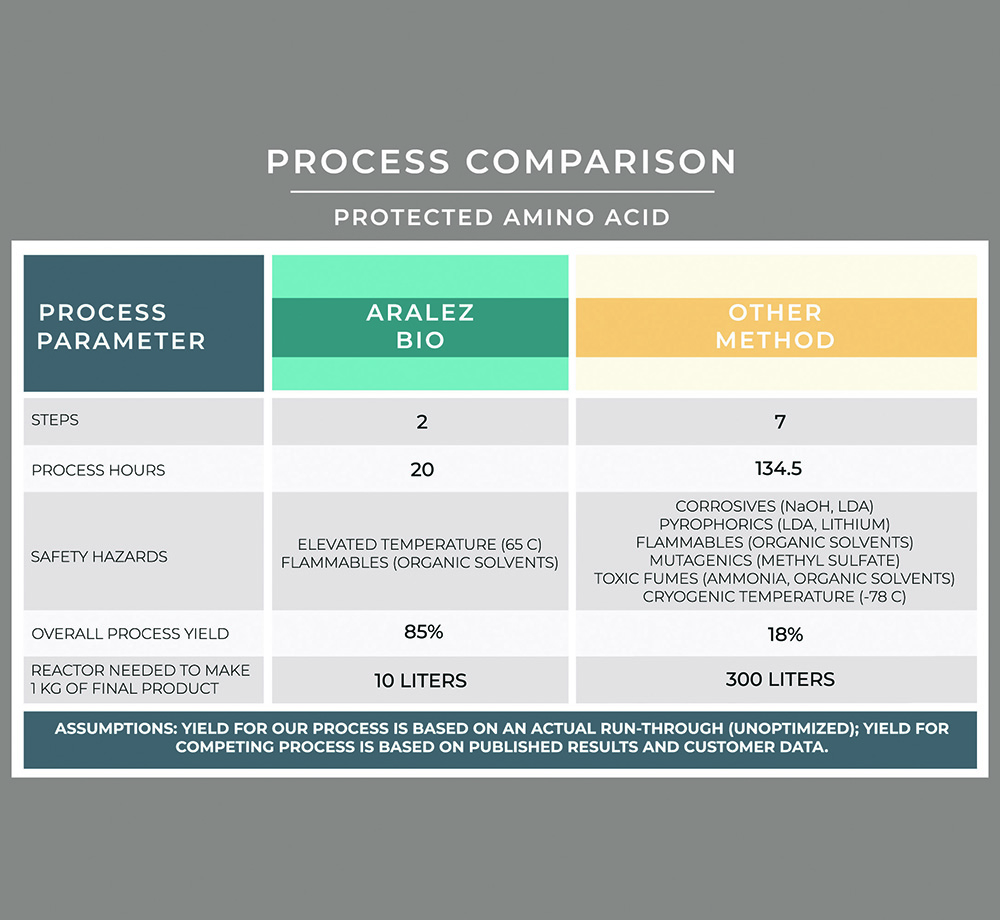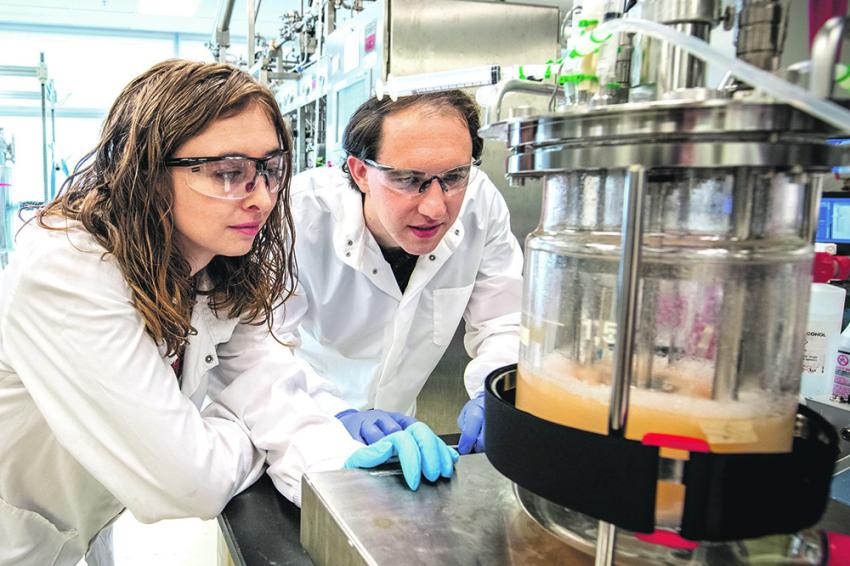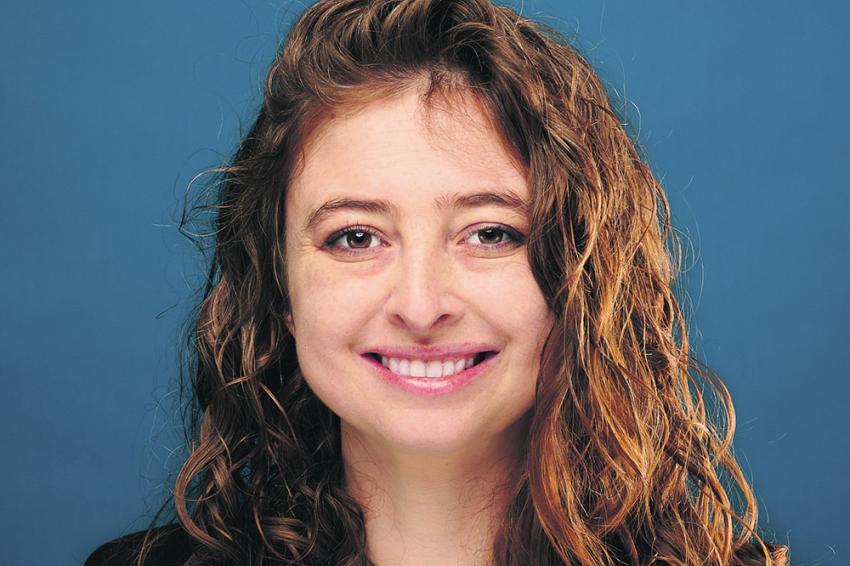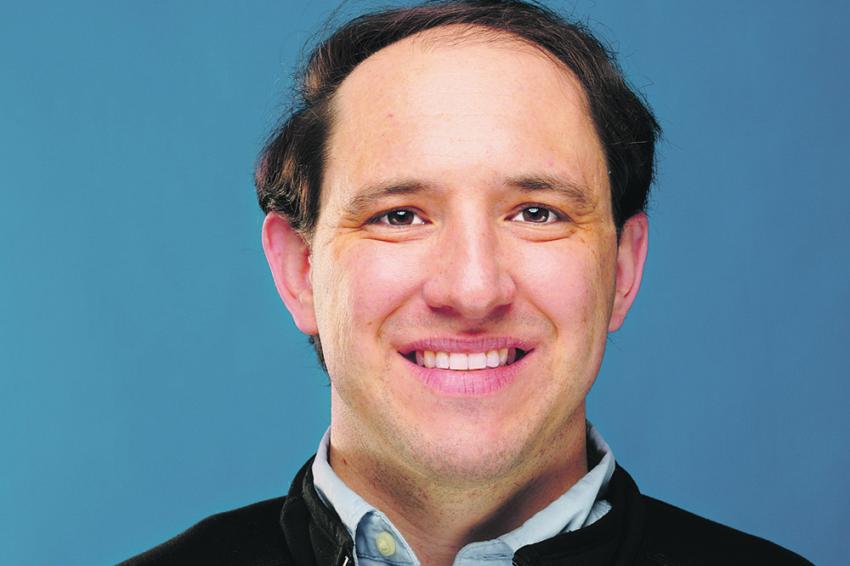Noncanonical Amino Acids Made by Enzymes
Biocatalysis Reduces Cost, Time and Risk to Make Diverse Amino Acids at Scale
Chiral noncanonical amino acids (ncAAs) of high quality are needed both to innovate in established therapeutic modalities and to create new drugs that target “undruggable” disease mechanisms. Co-founders, Christina Boville, CEO, and David Romney, CTO, explain their technology and outline plans for the company’s future development.
CHEManager: How did Aralez Bio start?
Christina Boville: David and I met at Caltech in the lab of Frances Arnold, who was awarded the 2018 Nobel Prize in Chemistry. Her work focuses on directed evolution, which is a way to engineer and improve desired protein characteristics. Years ago, she began working with tryptophan synthase, the enzyme that makes the amino acid tryptophan. We engineered it to take in different substrates and produce a wide range of tryptophan analogs in high yields. We incorporated in 2019 to commercialize this process and since then have built out a large selection of noncanonical amino acids that give chemists access to new chemical space.
What are noncanonical amino acids?
David Romney: First the significance: 12% of the top-selling drugs contain at least one noncanonical amino acid (ncAA) and newsworthy drugs like GLP-1 agonists, macrocycles, and antibody drug conjugates contain ncAAs. Many new peptide drugs are composed of greater than 50% ncAAs. Noncanonical amino acids are any amino acids beyond the twenty proteinogenic amino acids. Proteinogenic amino acids are used by all living things to make peptides and proteins. Many ncAAs are natural, while others have been dreamed up by chemists to serve a particular function. We focus on ncAAs that are at the intersection of hard-to-make and therapeutically interesting. For example, ncAAs containing aromatic side chains can be prohibitively expensive to make but are needed and critically important in actuating binding to a drug target.
What have been some of your biggest challenges in bringing these to market?
C. Boville: Access to high quality ncAAs is a long-standing issue in drug development. Many ncAAs are impractical to make even at research scale. Other ncAAs require contending with high costs, long lead times, and supply chain risks when scaled to commercial quantities. Since ncAAs have been effectively unavailable at the scope and scale needed by the industry, many opportunities to deploy ncAAs have gone untapped. Despite the compelling need for our products, as a new product area we have to take the time to understand our customer’s timelines and requirements, then match our development to their needs.
Why are amino acids the key to solving the new drug development puzzle?
D. Romney: There have been basically three classes of traditional drugs — small molecules, medium-sized peptides, and large biologics. These are loosely based on the “lock-and-key model” in which a drug binds very tightly to a specific site of a protein. Noncanonical amino acids are useful across these established modalities. However, for many complex diseases, such as cancer, that interaction is just the start of a complex cascade of signaling that is dominated by protein-protein interactions (PPIs). Next-generation drugs disrupt these PPIs by targeting multiple, weaker binding spots spread across larger areas. Small molecule drugs cannot span the sites while large molecules are usually too big to access the locale. Peptides — small to medium sized drugs that are composed of amino acids — can be made the right size with the right properties to access and then disrupt PPIs.
How is biocatalysis green manufacturing?
C. Boville: Biocatalysis means using nature to improve chemical manufacturing. Enzymes adhere to many of the principles of green chemistry: they work in water, which reduces the need for harsh solvents, and they often accomplish in a single step what would take multiple steps in a traditional process.
What are other advantages of using enzymes?
D. Romney: It’s about producing highly pure, chiral compounds. Enzymes are also very versatile tools for making large libraries of related products. Early studies showed that our flagship enzyme could make diverse tryptophan analogs from slightly modified starting materials. Since then, we have engineered our enzymes to produce an even broader scope of products. We now have variants that accept over 500 ncAA side chains, and 75% of products are unique to our platform.
 Business Idea
Business Idea
Key Building Blocks for New Drugs
Supplying diverse, high quality starting materials is a decades-old supply-chain challenge for drug development. Aralez Bio supplies unique noncanonical amino acids (ncAAs) made using enzymes for the next generation of therapeutics. Enzymes make pure, chiral products with fewer and more sustainable synthesis steps, meaning ncAAs can be made at commercial scales without cost overruns or project delays. Aralez Bio uses Nobel Prize-winning technology to produce an ever-expanding platform of engineered enzymes, which in turn make thousands of unique, high purity ncAAs, many of which have never been available before.
The twenty proteinogenic amino acids are the building blocks of the protein “machinery” controlling virtually all functions of the body. Chemically related to these vital amino acids, ncAAs share similar biocompatibility, and are used across bio-based industries such as biopharma, cosmeceuticals, and agricultural biotechnology. Aralez Bio offers these compounds end-to-end from R&D through clinical trials to commercial production. Aralez Bio works with companies of all sizes to do catalog sales or structured partnerships.
Aralez Bio’s biocatalytic platform is built on three solid biotech foundations which together allow for both chemical diversity and large-scale production of highly pure ncAAs:
- Step 1: Protein engineering techniques — perfected over the past two decades — create enzyme diversity. Enzymes are evolved by making small changes in their DNA code and selecting for their ability to synthesize specific amino acids at high yields and high purity. More enzyme diversity equals more amino acid diversity.
- Step 2: Enzymes are then produced at any scale using industrial fermentation techniques which have been around for several decades. Larger reactors produce larger batches of enzymes.
- Step 3: These enzyme batches are then used in simple chemical reactors to allow large-scale manufacturing of ncAAs.

 Elevator Pitch
Elevator Pitch
Biocatalytic Platform for Noncanonical Amino Acids
Aralez Bio was spun out in 2019 from the lab of Nobel laureate and Caltech professor Frances Arnold. The San Leandro-based start-up uses enzymes to make thousands of novel noncanonical amino acids (ncAAs) readily accessible for the first time at both lab and commercial scales via efficient, sustainable biomanufacturing. Aralez Bio’s biocatalytic platform produces high-quality, chiral building blocks that enable drug developers to create the next generation of therapeutics to treat diseases previously considered undruggable. Diverse ncAAs are useful across all stages of drug development from hit identification, to lead optimization, and to clinical/commercial scale-up. Noncanonical amino acids are found in blockbuster peptide drugs such as Semaglutide as well as in the latest generation of drug modalities such as macrocycles and antibody drug conjugates (ADCs). Aralez Bio makes unique, never-seen-before ncAAs and creates isomeric series of ncAAs that allow for fine-tuning of chemical properties.
Milestones
2019
- Incorporation of Aralez Bio
- Move to San Francisco and incubation at Lawrence Berkeley National Lab
- Pre-seed funding round raised
- First 1 g quantities sold
- Production process for flagship product line: tryptophan analogs established
2020
- Independent lab space established
- First 100 g quantity sold
- 1 kg made in production
- Launch of β-branched amino acid analogs
2021
- Enzyme production scaled to 100 L
- N-methylated amino acid production process established
2022
- ISO 9001:2015 certification
- Development of tyrosine analog process
2023
- Scale-up of amino acid production to 10 kg
- Launch of phenylalanine, naphthylalanine, D-amino acid analogs
- Introduction of structure-activity relationship kits
Roadmap
2024
- Market launch of α-methyl-α-amino acids and proline analogs
- Production scale up to 100 kg
Personal Profile
Christina Boville is co-founder and CEO of Aralez Bio. She received her Ph.D. in biochemistry from the University of Colorado and then conducted her postdoctoral research at Caltech as a Resnick Prize Postdoctoral Fellow, where she co-developed the enzyme platform used by Aralez Bio. She founded Aralez Bio in 2019 with David Romney and Caltech professor and Nobel laureate Frances Arnold.
Personal Profile
David Romney is co-founder and CTO of Aralez Bio. He received his Ph.D. in chemistry from Yale University, where he worked on amino acid and peptide synthesis and was recognized in 2015 with the Richard Wolfgang Prize in Chemistry. He then joined Caltech professor and Nobel laureate Frances Arnold’s lab as a NIH Postdoctoral Scholar, where he co-developed the enzyme platform used by Aralez Bio.








